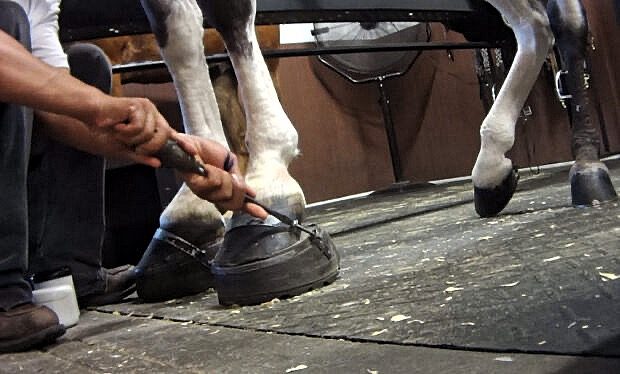The Animal and Plant Health Inspection Service (APHIS) opens public comments Monday, Aug. 21, 2023, on its proposal for new Horse Protection Act requirements that aim to eliminate horse soring.
Soring is the intentional application of substances or devices to horses’ limbs to inflict pain to achieve an exaggerated high-stepping gait, known as The Big Lick, in show rings.
“Soring has no place in Walking Horse shows,” says Jenny Lester-Moffitt, undersecretary for the United States Department of Agriculture (USDA) for Marketing and Regulatory Programs. “This unnecessary abuse harms horses and makes it harder for those who properly care for their horses to compete. By strengthening the HPA regulations, we can all work to eliminate soring, which will improve the welfare of horses competing in these shows and level the competitive playing field for everyone in the industry, which should only help it thrive.”
Proposed Farrier Changes
Many of the proposed rule changes are similar to those proposed in the 2017 APHIS rule, as well as the Prevent All Soring Tactics (PAST) legislation that has been put forth by both houses of Congress over the past several years. The proposed changes to farriery prohibit “any device, method, practice, or substance applied to any horse that could hide or mask evidence of soring, as well as all action devices and non-therapeutic pads and wedges, and substances applied about the hoof.”
While the current regulation prohibits pads or other devices on yearling horses that elevate or change the angle more than 1 inch at the heel, the new proposal will eliminate all pads unless they are applied for therapeutic purposes.
“Altering the angulation of a horse’s feet and legs can cause painful lameness, soreness, and inflammation by transferring concussive impact and weight-bearing pressures to joints and other parts of the horse not normally subjected to these forces,” states the rule. “Elevating the foot using stacked hoof pads, or ‘performance packages,’ can also cause an increase in tension in the tendons leading to inflammation, as can extra weight on the horse’s foot.”
Citing an Auburn University study, the proposed rule also makes the case that raising heels with only pads results in swollen flexor tendons and inflammation. The packages also limit the ability to detect pressure soring since the solar surface of the foot is covered. Pressure soring involves the use of items such as bolts, screws, hoof packing and other materials to create force on the sole as a way to influence the horse’s gait.
The proposed 2017 rule initially called for the prohibition of pads for all breeds before the comment period opened. The 2023 version avoids this controversy.
“We considered prohibiting all non-therapeutic pads, action devices, substances, and other practices for all breeds at all covered events, but in doing so we would unfairly conflate those breeds that do not sore for competitive advantage with those that do,” it states.
The proposal defines an action device as “any boot, collar, chain, roller, beads, bangles, or other devices, which encircles or is placed upon the lower extremity of the leg, or slide up and down the leg so as to cause friction, or which can strike the hoof, coronet band or fetlock joint.”
The proposed rule also would prohibit all artificial toe length extensions unless it has been prescribed and receiving therapeutic treatment.
“Toe extensions can be used to sore horses by increasing stress on certain tendons and ligaments,” states the rule.
In addition, the proposed rule also prohibits:
- Grinding or trimming the sole of the hoof to expose spongy, sensitive tissues underneath the sole.
- The removal or trimming of normal support structures of the hoof wall. Removing the support causes the sole to bear all of the weight. This is called “rolling the sole.”
New Research
The 2017 rule was set to amend the HPA in the waning days of the Obama administration; however, officials failed to publish it in the Federal Register before the end of the president’s term. The Trump administration withdrew all unpublished rules and sent them back to the relevant agencies for review. The final rule was not resurrected. However, the Circuit Court of Appeals for the District of Columbia found the withdrawal illegal. The court found that APHIS could propose the withdrawal, and publish it in the Federal Register with a public comment period. APHIS concluded the comment period on Aug. 22, 2023. APHIS’ withdrawal was in part because its new proposed rule incorporates new information and research, including from “Review of Methods for Detecting Soreness in Horses,” which was published by the National Academies of Science in 2021.
NAS believes that a regulatory change to the inspection component of the Horse Protection program is necessary to eliminate the conflicts of interest and problems within the current proposal that have further encouraged soring. Although the study began in 2017, NAS evaluated the proposal more recently to add a change in the way the protection inspections are conducted. APHIS added the NAS changes in hopes of creating more consistency throughout inspections that are based on scientific principles.
NAS evaluated the current methods of these inspections created by APHIS, and Designated Qualified Personnel (DQPs) for detecting soreness in Tennessee Walking Horses and evaluated current inspector qualifications. NAS continued to make changes throughout the proposal when reviewing the plan’s scar rule and visual criteria that determine the horse’s soreness. Throughout the research of the current rules and criteria, NAS has also uncovered problems within the training materials that were meant to be given to DQPs. The training was seemingly inadequate and provided conflicts of interest within the industry.
Because of the methods that were used, NAS found that many of the sored horses were going under the radar and not being detected. Inconsistencies in diagnostic techniques provided by the DQPs continued to show that the inspections were not as adequate. NAS mentions that “during palpation, DQPs ‘showed large variations in the technique used to palpate the forelimbs from the carpus to the fetlock — from an absent to a very cursory palpation of limited areas at the palmar surface of the distal limb, with minimal attention given to the dorsal surface of the limb.”
During the study, NAS found that DQPs were not properly inspecting the horse’s movement or posture. Horses did not take enough steps in the examination to reveal whether a lameness was present. Very little seemed to come from the inspections entirely, it found.
NAS noted that not only were the DQPs not assigned by APHIS, but they did not have a veterinarian degree and were being instructed by trainers. Whereas APHIS designated DQPs would have a veterinarian degree and extensive medical training that could more adequately detect soring. As a result, NAS recommended that current regulations be discontinued. Only veterinarians with equine experience should be allowed to examine horses.
The proposed rule can be viewed in the Federal Register. Comments about the rule may be submitted at regulations.gov. APHIS will consider all comments received through Oct. 20, 2023.
After the rule is finalized, it will go into effect 270 days later to help the horses acclimate to flat shoeing.










Post a comment
Report Abusive Comment